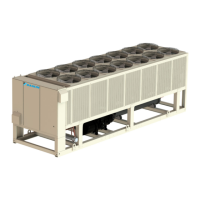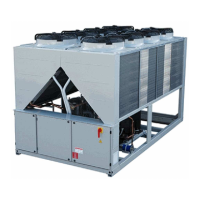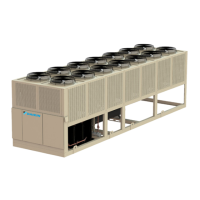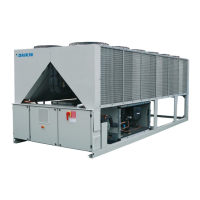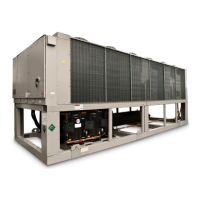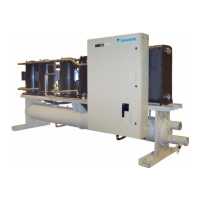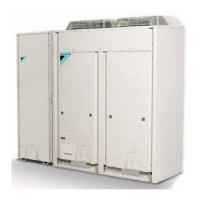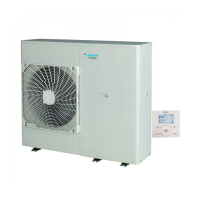Do you have a question about the Daikin Pathfinder AWV and is the answer not in the manual?
Checklist items for water systems in water-cooled chillers.
Checklist items for electrical systems.
Checklist items for miscellaneous systems.
Critical safety warning for lockout/tagout procedures before maintenance.
Hazard warning for electric shock during handling and service.
Warning about static discharge damaging electronic components.
Explanation of DANGER, WARNING, CAUTION, and NOTE symbols.
Explanation of unit model designation codes.
Table detailing operating temperature and fluid limits for AWV chillers.
Information on identifying unit nameplates and their locations.
Procedures for inspecting and handling the unit upon receipt.
Danger warning about improper rigging leading to severe injury or death.
Guidelines for ensuring adequate space for servicing chiller components.
Diagram showing spacing recommendations for optimal airflow.
Performance charts for capacity reduction and power increase.
Performance charts showing capacity reduction for side-by-side units.
Performance charts showing power increase for side-by-side units.
Performance charts for multiple side-by-side units.
Performance charts for multiple side-by-side units.
Charts for adjustment factors based on wall area and distance.
Charts for adjustment factors for IWSE models with screening walls.
Performance charts for pit installations.
Performance charts for pit installations.
Warning about POE oil interaction with PVC/CPVC piping.
Considerations for system water volume and compressor short cycling.
Methods and recommendations for protecting the evaporator from freezing.
Importance of controlling chilled water pumps via the chiller's microprocessor.
Diagram illustrating IWSE operation modes.
Diagram showing mechanical cooling operation.
Critical safety warning for electricians performing wiring.
Guidelines for connecting and operating the chiller with on-site generators.
Caution against using power factor correction capacitors with AWV chillers.
Note regarding grounding requirements for multiple power sources.
Step-by-step procedure for calculating performance derates for remote evaporators.
Notes and guidelines for field wiring of remote evaporator components.
Detailed wiring instructions for specific components like solenoid valves and sensors.
Description of piping layout for units with remote evaporators.
Guidelines for sizing upflow suction lines.
Dimensional drawing for specific fan configurations with brazed plate evaporator.
Table detailing unit dimensions for various configurations.
Note about water connection sizes and IWSE option changes.
Guidelines for installing isolators to reduce vibration and noise transmission.
Schematic diagram of a rubber-in-shear isolator.
Schematic diagram of a 2-spring isolator.
Schematic diagram of a 4-spring isolator.
Chart showing pressure drop vs. flow rate for ACH1000DQ models.
Chart showing pressure drop vs. flow rate for EV4027 models.
Chart showing pressure drop vs. flow rate for EV5039 models.
Chart showing pressure drop vs. flow rate for EV6639 models.
Importance of operator familiarity with the equipment and proper logging.
How to view unit software and BSP versions via the keypad.
Safety warning for personnel working on the control panel.
Lists of inputs/outputs for CC modules related to circuits.
Lists of inputs/outputs for EEXV modules.
Information on digital inputs for the RapidRestore module.
Information on digital inputs for compressor VFDs.
Information on analog and digital inputs/outputs for the waterside economizer module.
Discussion of set points applicable to the entire unit.
Table detailing default values and ranges for various unit set points.
Settings for adjusting sensor readings to account for calibration drift.
Set points related to unit administration and service support.
Discussion of set points with adjustable ranges based on other settings.
Table detailing set points for individual circuits.
Explanation of fan staging deadband settings and their dependency on VFD configuration.
Explains calculations for evaporator approach, slope, and pulldown rate.
How to enable or disable the chiller using set points and inputs.
How unit operating modes are determined by set points and inputs.
Explanation of the unit status display and its associated conditions.
Operation of the chiller in response to low ambient temperatures.
Details of the "Lockout and Stop" operation mode for low ambient conditions.
Details of the "Lockout Only" operation mode for low ambient conditions.
How pump outputs are determined based on the Evap Pump Control set point.
Logic for staging primary and standby pumps based on flow and time.
How auto pump control logic compares pump run hours.
Limits on the number of compressors that can run simultaneously.
Details of unit capacity adjustment in Cool Mode.
Conditions for shutting down circuits.
When load and unload commands are issued.
How unit capacity can be limited by a 4-20 mA signal.
How unit capacity can be limited by a network command.
Capability for faster restart and loading after power loss.
Calculation of approach values for evaporator and condenser.
Calculation of superheat values for suction, discharge, and economizer.
Calculation of oil pressure differential and pressure difference.
Calculation of pressure ratio for compressor operation.
Value used for triggering high condenser pressure hold alarms.
Value used for triggering high condenser pressure unload events.
Explanation of fan numbering and physical layout.
Describes the two control states for condenser fans.
Fan control logic for units without VFDs or with only the first fan VFD.
Manual control of fans for testing purposes.
Positioning logic for the Evaporator EXV.
How VFD compensates for smoother fan stage increases.
How the VFD speed signal is sent.
Fan control logic when the unit is in Waterside Econ state.
Positioning logic for the Evaporator EXV.
Describes the different states of the EXV.
Operation of the EXV in the purge state.
Operation of the EXV in the superheat control state.
Actions that signal an alarm has occurred.
Methods for clearing alarms and faults.
Explanation of the table format used for alarm details.
Details of unit-level alarms like GFP Fault.
Alarm triggered if evaporator water temperature drops too low.
Alarm for inverted evaporator water temperatures (EWT > LWT).
Alarm for faults with the Outside Air Temperature sensor.
Alarm triggered by an external input signal.
Alarm indicating communication failure with the AC module.
Alarm indicating failure of Evaporator Pump #1.
Alarm indicating failure of Evaporator Pump #2.
Alarm for an invalid demand limit input signal.
Alarm for communication failure with the Economizer EXV module.
Alarm for faults with the economizer temperature sensor.
Alarm for faults with the waterside economizer valves.
Introduction to circuit-specific alarms.
Alarm triggered by low evaporator pressure.
Diagram illustrating the conditions for low evaporator pressure faults.
Alarm related to the mechanical low pressure switch.
Alarm triggered by low pressure difference or ratio.
Alarm related to the mechanical high pressure switch.
Alarm for a significant drop in oil pressure.
Alarm for high compressor VFD output current.
Alarm for high compressor VFD temperature.
Alarm for low compressor VFD temperature.
Alarm for communication failure with the compressor VFD.
Alarm for communication failure with the CC module.
Alarm for faults with the condenser pressure sensor.
Alarm for faults with the oil pressure sensor.
Alarm for faults with the suction temperature sensor.
Alarm for faults with the economizer pressure sensor.
Alarm for faults with the economizer temperature sensor.
Alarm for motor errors in the economizer EXV.
Event logged when power is lost while the unit is running.
Alarm indicating a failed pumpdown operation.
Event that unloads compressor due to high condenser pressure.
Event that unloads compressor due to high VFD output current.
Event that holds compressor capacity due to VFD line current.
Event that unloads compressor due to high VFD line current.
Overview of the unit controller's interface and operation.
Diagram of the unit controller interface.
Explanation of password levels and entry procedures.
How to enter and use Edit Mode for changing set points.
Example screen menu structure.
Steps to take before performing the initial startup procedure.
Step-by-step procedure for starting the unit.
Procedure for temporarily shutting down the unit.
Procedure for starting the unit after an extended shutdown.
Detailed instructions for installing and calibrating the flow switch.
Critical note emphasizing the necessity of flow switch calibration.
General service checks to perform during startup and operation.
Using vibration readings as an indicator of potential maintenance issues.
Information on fan motor bearing lubrication and potential issues.
Handling precautions for POE oil.
Safety warning prior to cleaning coils.
Procedure for removing surface loaded fibers before water rinsing.
Recommended monthly clean water rinsing for coils.
Warning against using harsh chemicals or acid cleaners on coils.
Precautions for using high velocity water or compressed air for cleaning.
Warning about chemicals used for coil cleaning.
System for alternating compressor sequence to balance starts and run hours.
Inspection areas for compressor VFDs.
Information on training programs offered by Daikin Applied.
Details on the Limited Product Warranty and how to consult for details.
Information on locating parts and service offices.
Checklist items for water systems in water-cooled chillers.
Checklist items for electrical systems.
Checklist items for miscellaneous systems.
Critical safety warning for lockout/tagout procedures before maintenance.
Hazard warning for electric shock during handling and service.
Warning about static discharge damaging electronic components.
Explanation of DANGER, WARNING, CAUTION, and NOTE symbols.
Explanation of unit model designation codes.
Table detailing operating temperature and fluid limits for AWV chillers.
Information on identifying unit nameplates and their locations.
Procedures for inspecting and handling the unit upon receipt.
Danger warning about improper rigging leading to severe injury or death.
Guidelines for ensuring adequate space for servicing chiller components.
Diagram showing spacing recommendations for optimal airflow.
Performance charts for capacity reduction and power increase.
Performance charts showing capacity reduction for side-by-side units.
Performance charts showing power increase for side-by-side units.
Performance charts for multiple side-by-side units.
Performance charts for multiple side-by-side units.
Charts for adjustment factors based on wall area and distance.
Charts for adjustment factors for IWSE models with screening walls.
Performance charts for pit installations.
Performance charts for pit installations.
Warning about POE oil interaction with PVC/CPVC piping.
Considerations for system water volume and compressor short cycling.
Methods and recommendations for protecting the evaporator from freezing.
Importance of controlling chilled water pumps via the chiller's microprocessor.
Diagram illustrating IWSE operation modes.
Diagram showing mechanical cooling operation.
Critical safety warning for electricians performing wiring.
Guidelines for connecting and operating the chiller with on-site generators.
Caution against using power factor correction capacitors with AWV chillers.
Note regarding grounding requirements for multiple power sources.
Step-by-step procedure for calculating performance derates for remote evaporators.
Notes and guidelines for field wiring of remote evaporator components.
Detailed wiring instructions for specific components like solenoid valves and sensors.
Description of piping layout for units with remote evaporators.
Guidelines for sizing upflow suction lines.
Dimensional drawing for specific fan configurations with brazed plate evaporator.
Table detailing unit dimensions for various configurations.
Note about water connection sizes and IWSE option changes.
Guidelines for installing isolators to reduce vibration and noise transmission.
Schematic diagram of a rubber-in-shear isolator.
Schematic diagram of a 2-spring isolator.
Schematic diagram of a 4-spring isolator.
Chart showing pressure drop vs. flow rate for ACH1000DQ models.
Chart showing pressure drop vs. flow rate for EV4027 models.
Chart showing pressure drop vs. flow rate for EV5039 models.
Chart showing pressure drop vs. flow rate for EV6639 models.
Importance of operator familiarity with the equipment and proper logging.
How to view unit software and BSP versions via the keypad.
Safety warning for personnel working on the control panel.
Lists of inputs/outputs for CC modules related to circuits.
Lists of inputs/outputs for EEXV modules.
Information on digital inputs for the RapidRestore module.
Information on digital inputs for compressor VFDs.
Information on analog and digital inputs/outputs for the waterside economizer module.
Discussion of set points applicable to the entire unit.
Table detailing default values and ranges for various unit set points.
Settings for adjusting sensor readings to account for calibration drift.
Set points related to unit administration and service support.
Discussion of set points with adjustable ranges based on other settings.
Table detailing set points for individual circuits.
Explanation of fan staging deadband settings and their dependency on VFD configuration.
Explains calculations for evaporator approach, slope, and pulldown rate.
How to enable or disable the chiller using set points and inputs.
How unit operating modes are determined by set points and inputs.
Explanation of the unit status display and its associated conditions.
Operation of the chiller in response to low ambient temperatures.
Details of the "Lockout and Stop" operation mode for low ambient conditions.
Details of the "Lockout Only" operation mode for low ambient conditions.
How pump outputs are determined based on the Evap Pump Control set point.
Logic for staging primary and standby pumps based on flow and time.
How auto pump control logic compares pump run hours.
Limits on the number of compressors that can run simultaneously.
Details of unit capacity adjustment in Cool Mode.
Conditions for shutting down circuits.
When load and unload commands are issued.
How unit capacity can be limited by a 4-20 mA signal.
How unit capacity can be limited by a network command.
Capability for faster restart and loading after power loss.
Calculation of approach values for evaporator and condenser.
Calculation of superheat values for suction, discharge, and economizer.
Calculation of oil pressure differential and pressure difference.
Calculation of pressure ratio for compressor operation.
Value used for triggering high condenser pressure hold alarms.
Value used for triggering high condenser pressure unload events.
Explanation of fan numbering and physical layout.
Describes the two control states for condenser fans.
Fan control logic for units without VFDs or with only the first fan VFD.
Manual control of fans for testing purposes.
Positioning logic for the Evaporator EXV.
How VFD compensates for smoother fan stage increases.
How the VFD speed signal is sent.
Fan control logic when the unit is in Waterside Econ state.
Positioning logic for the Evaporator EXV.
Describes the different states of the EXV.
Operation of the EXV in the purge state.
Operation of the EXV in the superheat control state.
Actions that signal an alarm has occurred.
Methods for clearing alarms and faults.
Explanation of the table format used for alarm details.
Details of unit-level alarms like GFP Fault.
Alarm triggered if evaporator water temperature drops too low.
Alarm for inverted evaporator water temperatures (EWT > LWT).
Alarm for faults with the Outside Air Temperature sensor.
Alarm triggered by an external input signal.
Alarm indicating communication failure with the AC module.
Alarm indicating failure of Evaporator Pump #1.
Alarm indicating failure of Evaporator Pump #2.
Alarm for an invalid demand limit input signal.
Alarm for communication failure with the Economizer EXV module.
Alarm for faults with the economizer temperature sensor.
Alarm for faults with the waterside economizer valves.
Introduction to circuit-specific alarms.
Alarm triggered by low evaporator pressure.
Diagram illustrating the conditions for low evaporator pressure faults.
Alarm related to the mechanical low pressure switch.
Alarm triggered by low pressure difference or ratio.
Alarm related to the mechanical high pressure switch.
Alarm for a significant drop in oil pressure.
Alarm for high compressor VFD output current.
Alarm for high compressor VFD temperature.
Alarm for low compressor VFD temperature.
Alarm for communication failure with the compressor VFD.
Alarm for communication failure with the CC module.
Alarm for faults with the condenser pressure sensor.
Alarm for faults with the oil pressure sensor.
Alarm for faults with the suction temperature sensor.
Alarm for faults with the economizer pressure sensor.
Alarm for faults with the economizer temperature sensor.
Alarm for motor errors in the economizer EXV.
Event logged when power is lost while the unit is running.
Alarm indicating a failed pumpdown operation.
Event that unloads compressor due to high condenser pressure.
Event that unloads compressor due to high VFD output current.
Event that holds compressor capacity due to VFD line current.
Event that unloads compressor due to high VFD line current.
Overview of the unit controller's interface and operation.
Diagram of the unit controller interface.
Explanation of password levels and entry procedures.
How to enter and use Edit Mode for changing set points.
Example screen menu structure.
Steps to take before performing the initial startup procedure.
Step-by-step procedure for starting the unit.
Procedure for temporarily shutting down the unit.
Procedure for starting the unit after an extended shutdown.
Detailed instructions for installing and calibrating the flow switch.
Critical note emphasizing the necessity of flow switch calibration.
General service checks to perform during startup and operation.
Using vibration readings as an indicator of potential maintenance issues.
Information on fan motor bearing lubrication and potential issues.
Handling precautions for POE oil.
Safety warning prior to cleaning coils.
Procedure for removing surface loaded fibers before water rinsing.
Recommended monthly clean water rinsing for coils.
Warning against using harsh chemicals or acid cleaners on coils.
Precautions for using high velocity water or compressed air for cleaning.
Warning about chemicals used for coil cleaning.
System for alternating compressor sequence to balance starts and run hours.
Inspection areas for compressor VFDs.
Information on training programs offered by Daikin Applied.
Details on the Limited Product Warranty and how to consult for details.
Information on locating parts and service offices.
